
|
Now it is very bright as 8.9 mag (Mar. 15, Chris Wyatt). It is observable at 8 mag for a long time from 2022 to 2023. In the Southern Hemisphere, it stays observable for a long time. In the Northern Hemisphere, it is not observable until summer.
Date(TT) R.A. (2000) Decl. Delta r Elong. m1 Best Time(A, h)
Mar. 25 3 26.72 -43 18.4 2.440 2.162 62 8.4 19:29 ( 61, 42)
Apr. 1 3 43.71 -39 19.7 2.519 2.211 60 8.6 19:19 ( 66, 41)
|
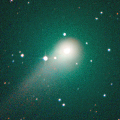
|
Now it is 10.3 mag (Mar. 14, Osamu Miyazaki). It stays bright as 10 mag for a long time until autumn. In the Northern Hemisphere, it becomes unobservable temporarily in early April. But it becomes observable again in summer. In the Southern Hemipshere, it stays unobservable until summer.
Date(TT) R.A. (2000) Decl. Delta r Elong. m1 Best Time(A, h)
Mar. 25 2 4.82 33 58.8 2.934 2.286 41 9.9 19:29 (122,-14)
Apr. 1 2 10.45 32 13.8 3.012 2.270 35 10.0 19:19 (119,-15)
|
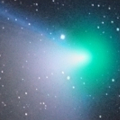
|
It approached to Earth down to 0.29 a.u. in early February, and it brightened up to 4.5 mag (Feb. 1, Juan Jose Gonzalez). Now it is fading. It has already faded down to 9.3 mag (Mar. 16, Chris Wyatt). In the Northern Hemisphere, it stays observable until mid April. In the Southern Hemisphere, it stays observable in good condition after this.
Date(TT) R.A. (2000) Decl. Delta r Elong. m1 Best Time(A, h)
Mar. 25 4 48.09 -6 27.6 1.635 1.579 68 10.1 19:29 (116, 42)
Apr. 1 4 52.40 -7 39.4 1.822 1.654 64 10.5 19:19 (112, 40)
|
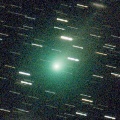
|
It brightened very rapidly. Now it is very bright as 10.5 mag (Mar. 19, Osamu Miyazaki). It will be fading gradually after this. In the Northern Hemisphere, it stays observable for a long time. But it locates low until spring. In the Southern Hemisphere, it is not observable until June.
Date(TT) R.A. (2000) Decl. Delta r Elong. m1 Best Time(A, h)
Mar. 25 23 35.10 45 15.8 2.361 1.793 44 10.4 4:42 (234,-31)
Apr. 1 23 48.95 43 53.3 2.447 1.818 41 10.6 4:48 (234,-28)
|

|
Now it is 13.3 mag (Mar. 18, Chris Wyatt). It is expected to brighten up to 10 mag from spring to summer. However, it is fainter than expected recently. In the Southern Hemisphere, it stays observable in good condition for a long time. In the Northern Hemisphere, it is not observable until 2024 autumn.
Date(TT) R.A. (2000) Decl. Delta r Elong. m1 Best Time(A, h)
Mar. 25 20 0.83 -42 11.6 3.272 3.105 71 11.0 4:42 (296, 52)
Apr. 1 20 8.92 -44 23.8 3.158 3.096 77 10.9 4:48 (299, 57)
|
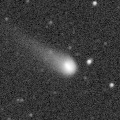
|
Now it is 11.6 mag (Mar. 21, Marco Goiato). It stays 12 mag until summer. It stays observable in good condition for a long time.
Date(TT) R.A. (2000) Decl. Delta r Elong. m1 Best Time(A, h)
Mar. 25 12 6.04 -1 21.8 2.628 3.624 178 11.7 23:54 (180, 57)
Apr. 1 11 50.78 -1 38.7 2.642 3.624 167 11.8 23:11 (180, 57)
|
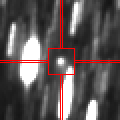
|
Now it is 13.9 mag (Mar. 18, Chris Wyatt). It will brighten very rapidly. It is expected to be observable at 11 mag in excellent condition from spring to summer. It is fainter than this ephemeris recently.
Date(TT) R.A. (2000) Decl. Delta r Elong. m1 Best Time(A, h)
Mar. 25 18 37.80 -22 2.7 1.855 2.028 85 12.4 4:42 (249, 63)
Apr. 1 18 50.90 -20 59.0 1.774 2.018 88 12.1 4:48 (240, 66)
|

|
It brightened up to 8.3 mag in last winter (Jan. 6, 2022, Toshiyuki Takahashi). Now it is fading. But it is bright as 12.0 mag still now (Mar. 18, Chris Wyatt). It is observable in excellent condition in the Southern Hemisphere. It locates low in the Northern Hemisphere.
Date(TT) R.A. (2000) Decl. Delta r Elong. m1 Best Time(A, h)
Mar. 25 9 5.40 -34 9.6 4.603 5.243 125 12.2 20:55 (180, 89)
Apr. 1 9 3.44 -33 42.0 4.688 5.285 121 12.3 20:26 (180, 89)
|
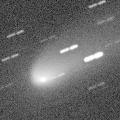
|
Now it is 12.1 mag (Mar. 18, Osamu Miyazaki). It stays 12 mag until spring.
Date(TT) R.A. (2000) Decl. Delta r Elong. m1 Best Time(A, h)
Mar. 25 17 32.33 -19 1.0 1.410 1.867 100 12.3 4:42 (214, 71)
Apr. 1 17 39.89 -18 55.5 1.373 1.901 105 12.4 4:48 (194, 73)
|
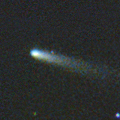
|
Now it is 14.7 mag (Mar. 19, Michael Jager). It will brighten very rapidly up to 11.5 mag in April. In the Southern Hemisphere, it stays observable in good condition for a long time. In the Northern Hemisphere, it is not observable from mid April to mid June.
Date(TT) R.A. (2000) Decl. Delta r Elong. m1 Best Time(A, h)
Mar. 25 15 32.59 30 52.2 0.199 1.117 122 14.2 3:23 (180, 24)
Apr. 1 17 9.28 32 6.6 0.143 1.049 106 12.8 4:31 (180, 23)
|
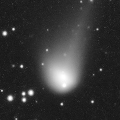
|
Now it is bright as 13.1 mag (Mar. 19, Michael Jager). It stays 13 mag until spring. It stays observable in good condition for a while after this.
Date(TT) R.A. (2000) Decl. Delta r Elong. m1 Best Time(A, h)
Mar. 25 15 44.59 11 36.6 4.209 4.863 126 13.0 3:37 (180, 44)
Apr. 1 15 43.76 12 57.0 4.176 4.891 131 13.0 3:09 (180, 42)
|
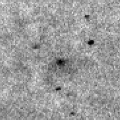
|
Now it is 12.8 mag (Mar. 8, Taras Prystavski). The condition is bad in this apparition. Appearing in the morning sky in the Southern Hemisphere. It is not observable until May in the Northern Hemisphere.
Date(TT) R.A. (2000) Decl. Delta r Elong. m1 Best Time(A, h)
Mar. 25 21 58.72 -18 51.6 2.347 1.691 38 13.2 4:42 (279, 21)
Apr. 1 22 17.14 -17 31.6 2.334 1.715 41 13.3 4:48 (276, 23)
|
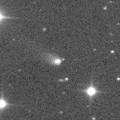
|
It brightened up to 14.5 mag in February (Feb. 16, Ken-ichi Kadota). It is expected to brighten up to 8 mag in July. Now it is not observable. In the Southern Hemisphere, it will appear in the morning sky at 13 mag in mid April, and it will be observable in excellent condition at the high light. In the Northern Hemisphere, it is not observable until June, and it becomes very low at the high lihght.
Date(TT) R.A. (2000) Decl. Delta r Elong. m1 Best Time(A, h)
Mar. 25 0 28.74 -11 8.4 3.241 2.282 13 13.6 19:29 ( 71, -8)
Apr. 1 0 30.88 -10 57.4 3.163 2.216 15 13.5 4:48 (289, -7)
|

|
Now it is 14.6 mag (Mar. 18, Chris Wyatt). The brightness evolution is slower than originally predicted. It stays 14 mag until summer. In the Northern Hemisphere, it will too low to observe in late March. In the Southern Hemisphere, it stays observable in good condition for a long time.
Date(TT) R.A. (2000) Decl. Delta r Elong. m1 Best Time(A, h)
Mar. 25 3 47.28 -19 14.4 2.460 2.080 56 13.7 19:29 ( 91, 37)
Apr. 1 3 55.95 -20 4.4 2.485 2.064 54 13.7 19:19 ( 89, 36)
|
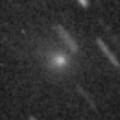
|
Bright new comet. Now it is 13.2 mag (Mar. 2, Giuseppe Pappa). In the Southern Hemisphere, it stays observable in good condition after this. In the Northern Hemisphere, it is not observable after this.
Date(TT) R.A. (2000) Decl. Delta r Elong. m1 Best Time(A, h)
Mar. 25 21 39.66 -43 19.0 1.724 1.440 56 13.8 4:42 (302, 35)
Apr. 1 22 3.64 -47 48.8 1.707 1.524 62 14.0 4:48 (307, 38)
|
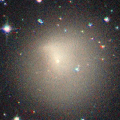
|
Now it is 13.8 mag (Mar. 6, Ken-ichi Kadota).
Date(TT) R.A. (2000) Decl. Delta r Elong. m1 Best Time(A, h)
Mar. 25 6 19.71 27 56.6 5.991 6.083 90 13.8 19:29 (161, 24)
Apr. 1 6 21.89 27 46.5 6.105 6.085 84 13.8 19:19 (157, 23)
|
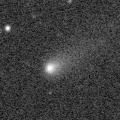
|
Now it is 14.9 mag (Mar. 18, Chris Wyatt). It will brighten rapidly up to 14 mag and will be observable in excellent condition in spring. In the Northern Hemisphere, it was observable in good condition in winter, but it becomes somewhat low in spring.
Date(TT) R.A. (2000) Decl. Delta r Elong. m1 Best Time(A, h)
Mar. 25 14 30.82 -24 12.7 1.498 2.350 139 14.2 2:24 (180, 79)
Apr. 1 14 25.94 -25 41.3 1.449 2.349 146 14.1 1:52 (180, 81)
|

|
It approaches to Sun down to 0.08 a.u. on Apr. 2, and it will brighten up to 13 mag. But it is not observable at that time. In the Northern Hemisphere, it appears in the evening sky in early April, but it will be fainter than 18 mag.
Date(TT) R.A. (2000) Decl. Delta r Elong. m1 Best Time(A, h)
Mar. 25 23 9.11 -13 33.0 0.931 0.373 21 17.9 4:42 (284, 4)
Apr. 1 0 31.81 0 5.4 1.067 0.106 4 14.2 4:48 (280,-13)
|
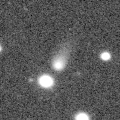
|
Now it is 14.6 mag (Mar. 18, Chris Wyatt). It is expected to brighten up to 7 mag in early 2024. In the Southern Hemisphere, it stays observable in good condition for a long time. It locates low in the Northern Hemisphere.
Date(TT) R.A. (2000) Decl. Delta r Elong. m1 Best Time(A, h)
Mar. 25 5 17.97 -30 49.9 4.365 4.285 78 14.5 19:29 ( 88, 60)
Apr. 1 5 21.23 -29 53.6 4.356 4.216 75 14.4 19:19 ( 88, 57)
|
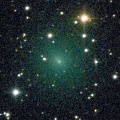
|
It brightened very rapidly up to 9.6 mag in late January (Jan. 25, Toshihiko Ikemura, Hirohisa Sato). Now it is fading. It has already faded down to 13.5 mag (Mar. 10, Masayoshi Yoshimi). It stays observable in good condition for a long time.
Date(TT) R.A. (2000) Decl. Delta r Elong. m1 Best Time(A, h)
Mar. 25 6 42.18 0 41.3 1.222 1.669 97 14.5 19:29 (157, 52)
Apr. 1 6 53.70 -1 49.6 1.349 1.730 93 15.1 19:19 (153, 54)
|
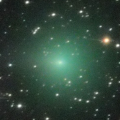
|
It brightened up to 9.7 mag in autumn (Oct. 23, Marco Goiato). Now it is fading. It has already faded down to 12.9 mag (Mar. 14, Thomas Lehmann). In the Southern Hemisphere, it stays observable in good condition for a long time. It locates low in the Northern Hemisphere.
Date(TT) R.A. (2000) Decl. Delta r Elong. m1 Best Time(A, h)
Mar. 25 18 39.69 -43 1.6 1.989 2.167 86 14.6 4:42 (299, 67)
Apr. 1 18 21.87 -43 59.9 1.884 2.224 96 14.8 4:48 (312, 75)
|
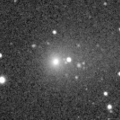
|
Now it is 13.8 mag (Mar. 11, Thomas Lehmann). It will be fading after this. It stays observable in good condition for a while.
Date(TT) R.A. (2000) Decl. Delta r Elong. m1 Best Time(A, h)
Mar. 25 8 34.92 20 47.8 1.380 2.087 122 14.7 20:25 (180, 34)
Apr. 1 8 41.18 20 57.8 1.471 2.114 116 14.9 20:04 (180, 34)
|
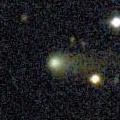
|
Now it is 14.7 mag (Mar. 14, W. Pei). It stays 14.5 mag and observable in good condition until spring.
Date(TT) R.A. (2000) Decl. Delta r Elong. m1 Best Time(A, h)
Mar. 25 9 21.62 29 17.5 2.681 3.395 128 14.7 21:12 (180, 26)
Apr. 1 9 23.08 29 25.0 2.764 3.403 122 14.7 20:46 (180, 26)
|
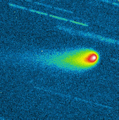
|
Now it is 15.3 mag (Mar. 11, Thomas Lehmann). It stays 14 mag in 2023. It will be unobservable soon. Then it is not observable until May in the Southern Hemisphere, or until June in the Northern Hemisphere.
Date(TT) R.A. (2000) Decl. Delta r Elong. m1 Best Time(A, h)
Mar. 25 2 33.64 -5 45.1 4.049 3.290 35 14.7 19:29 ( 93, 14)
Apr. 1 2 33.89 -4 37.9 4.106 3.278 29 14.7 19:19 ( 92, 10)
|
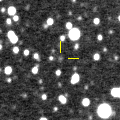
|
Now it is 15.3 mag (Mar. 16, Y. Sugiyama). It will brighten up to 13 mag from 2024 to 2025. It is observable in excllent condition in the Southern Hemisphere. It locates low in the Northern Hemisphere.
Date(TT) R.A. (2000) Decl. Delta r Elong. m1 Best Time(A, h)
Mar. 25 8 44.16 -36 15.7 5.838 6.402 120 15.2 20:34 ( 0, 89)
Apr. 1 8 43.75 -35 29.6 5.846 6.370 117 15.2 20:06 ( 0, 89)
|

|
Now it is 17.3 mag (Mar. 16, E. Cortes, N. Paul, B. Lutkenhoner). It will approach to Sun down to 0.8 a.u. in April, and it will brighten up to 15 mag. In the Southern Hemisphere, it stays observable in the extremely low sky. In the Northern Hemisphere, it is not observable after March.
Date(TT) R.A. (2000) Decl. Delta r Elong. m1 Best Time(A, h)
Mar. 25 22 9.54 -12 16.5 1.504 0.874 33 15.5 4:42 (274, 15)
Apr. 1 22 46.11 -9 19.2 1.523 0.847 31 15.3 4:48 (272, 13)
|
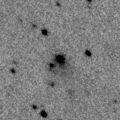
|
It approached to Sun down to 0.1 a.u. on Jan. 31. It was bright as 7.0-7.5 mag in early February (Feb. 5, Michael Jager). Now it is fading rapidly. It has already faded down to 12.0 mag (Mar. 6, Ken-ichi Kadota). It stays observable after this while the comet will be fading.
Date(TT) R.A. (2000) Decl. Delta r Elong. m1 Best Time(A, h)
Mar. 25 20 20.13 -8 6.5 1.571 1.360 59 15.3 4:42 (254, 35)
Apr. 1 20 20.14 -8 26.0 1.573 1.479 65 15.7 4:48 (247, 42)
|
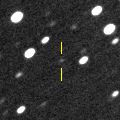
|
Now it is 15.4 mag (Mar. 5, Giuseppe Pappa). It is expected to brighten up to 12 mag from 2024 to 2025.
Date(TT) R.A. (2000) Decl. Delta r Elong. m1 Best Time(A, h)
Mar. 25 9 15.35 -11 14.8 5.140 5.884 134 15.4 21:05 (180, 66)
Apr. 1 9 10.54 -10 1.7 5.173 5.841 127 15.3 20:33 (180, 65)
|

|
It brightened up to 13.4 mag in last summer (July 7, Giuseppe Pappa). Now it is fading. It has already faded down to 15.5 mag (Mar. 3, Ken-ichi Kadota). It stays 15-16 mag until summer. It stays observable in good condition for a while.
Date(TT) R.A. (2000) Decl. Delta r Elong. m1 Best Time(A, h)
Mar. 25 18 5.69 9 1.2 3.322 3.498 91 15.4 4:42 (206, 42)
Apr. 1 18 2.25 11 32.3 3.250 3.534 98 15.4 4:48 (193, 43)
|

|
Now it is 14.8 mag (Dec. 8, ATLAS Chile). In the Southern Hemisphere, apperaing in the morning sky. In the Northern Hemisphere, it will become observable in late May.
Date(TT) R.A. (2000) Decl. Delta r Elong. m1 Best Time(A, h)
Mar. 25 22 57.54 -14 3.6 4.172 3.291 24 15.4 4:42 (283, 6)
Apr. 1 23 6.96 -13 9.7 4.144 3.303 28 15.4 4:48 (279, 11)
|
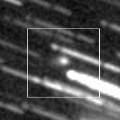
|
Now it is 16.5 mag (Mar. 19, Toshihiko Ikemura, Hirohisa Sato). It is expected to brighten up to 11.5 mag in 2024 spring. It stays observable in good condition for a long time. At the high light, it will be observable in excellent condition in the Southern Hemisphere, but it will be low in the Northern Hemisphere.
Date(TT) R.A. (2000) Decl. Delta r Elong. m1 Best Time(A, h)
Mar. 25 18 35.51 17 47.6 4.408 4.423 84 15.7 4:42 (210, 32)
Apr. 1 18 33.26 18 28.6 4.255 4.373 90 15.6 4:48 (200, 34)
|
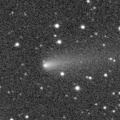
|
It continued brightening even after the perihelion passage. Now it is 15.4 mag (Mar. 5, Giuseppe Pappa). It will be fading after this, and it will be fainter than 18 mag in July. It is observable in good condition in the Northern Hemisphere. It locates somewhat low in the Southern Hemisphere.
Date(TT) R.A. (2000) Decl. Delta r Elong. m1 Best Time(A, h)
Mar. 25 7 35.18 25 43.8 2.307 2.776 107 15.7 19:29 (179, 29)
Apr. 1 7 40.30 25 35.6 2.418 2.799 101 15.8 19:19 (176, 29)
|

|
Now it is 16.1 mag (Mar. 9, B. Lutkenhoner, N. Paul, E. Cortes). It will brighten rapidly up to 13.5 mag in summer. In the Southern Hemisphere, it stays observable until August. In the Northern Hemisphere, it is not observable until June. But it stays observable in good condition after that.
Date(TT) R.A. (2000) Decl. Delta r Elong. m1 Best Time(A, h)
Mar. 25 22 59.30 -35 34.5 2.678 2.032 40 16.0 4:42 (301, 18)
Apr. 1 23 14.76 -33 1.7 2.616 1.994 42 15.8 4:48 (297, 20)
|
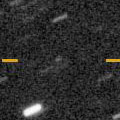
|
Now it is 16.5 mag (Mar. 18, J.-C. Merlin). It stays observable at 14-15 mag from spring to autumn. It locates somewhat low in the Northern Hemisphere.
Date(TT) R.A. (2000) Decl. Delta r Elong. m1 Best Time(A, h)
Mar. 25 18 12.95 -14 33.2 2.889 3.066 90 16.0 4:42 (228, 62)
Apr. 1 18 18.80 -14 53.5 2.779 3.051 96 15.8 4:48 (215, 66)
|
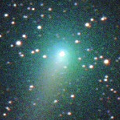
|
It brightened up to 9.3 mag in early summer in 2022 (June 5, Chris Wyatt). Now it is fading. It has already faded down to 16.6 mag (Mar. 19, Toshihiko Ikemura, Hirohisa Sato). In the Southen Hemisphere, it stays observable in good condition for a long time. It locates somewhat low in the Northern Hemisphere.
Date(TT) R.A. (2000) Decl. Delta r Elong. m1 Best Time(A, h)
Mar. 25 6 41.32 -14 4.9 3.543 3.796 97 16.1 19:29 (145, 65)
Apr. 1 6 41.19 -12 2.7 3.705 3.860 91 16.3 19:19 (139, 61)
|
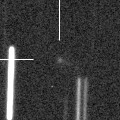
|
Now it is 17.6 mag (Mar. 5, F. Kugel, J. Nicolas). It will brighten up to 13 mag in summer. In the Northern Hemisphere, it stays observable in good condition for a long time. In the Southern Hemisphere, it is not observable until August.
Date(TT) R.A. (2000) Decl. Delta r Elong. m1 Best Time(A, h)
Mar. 25 2 29.29 69 28.8 1.945 1.885 71 16.2 19:29 (157,-28)
Apr. 1 2 21.74 67 43.2 1.988 1.823 65 16.1 19:19 (154,-30)
|
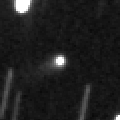
|
Now it is 15.9 mag (Mar. 14, Hirohisa Sato). It stays observable at 16 mag for a long time from early 2023 to early 2024. In the Northern Hemisphere, it is observable only until 2023 spring.
Date(TT) R.A. (2000) Decl. Delta r Elong. m1 Best Time(A, h)
Mar. 25 8 40.41 -7 12.4 3.386 4.059 126 16.2 20:30 (180, 62)
Apr. 1 8 34.30 -7 29.8 3.454 4.035 119 16.3 19:56 (180, 63)
|

|
It was observed at 15 mag from 2021 to 2022. Now it is fading. Now it is 17.2 mag (Mar. 8, J. L. Virlichie, P. Traverse, H. Roy, G. Houdin). In the Southern Hemisphere, it stays observable in excellent condition for a long time. In the Northern Hemiphere, it is not observable after this.
Date(TT) R.A. (2000) Decl. Delta r Elong. m1 Best Time(A, h)
Mar. 25 14 4.28 -73 6.0 5.932 6.287 106 16.4 1:59 ( 0, 52)
Apr. 1 13 43.14 -73 36.6 5.906 6.318 109 16.4 1:11 ( 0, 51)
|
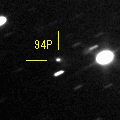
|
Now it is 16.9 mag (Mar. 19, Toshihiko Ikemura, Hirohisa Sato). It is observable at 16.5 mag in good condition in spring. It locates somewhat low in the Southern Hemisphere.
Date(TT) R.A. (2000) Decl. Delta r Elong. m1 Best Time(A, h)
Mar. 25 8 17.54 28 4.8 1.638 2.262 116 16.5 20:08 (180, 27)
Apr. 1 8 22.06 27 35.6 1.702 2.254 110 16.5 19:45 (180, 28)
|
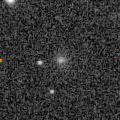
|
Now it is 17.0 mag (Mar. 14, ATLAS Chile). It moves along an almost circular orbit. It seems to be bright temporarily in outburst.
Date(TT) R.A. (2000) Decl. Delta r Elong. m1 Best Time(A, h)
Mar. 25 10 42.80 26 9.3 5.301 6.141 144 16.5 22:32 (180, 29)
Apr. 1 10 40.38 26 12.3 5.361 6.141 138 16.5 22:02 (180, 29)
|
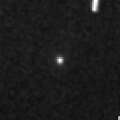
|
Now it is 17.7 mag (Mar. 18, Toshihiko Ikemura, Hirohisa Sato). It will brighten up to 13 mag from June to August. In the Northern Hemisphere, it stays observable in excellent condition. In the Southern Hemisphere, it becomes unobservable from late April to early August.
Date(TT) R.A. (2000) Decl. Delta r Elong. m1 Best Time(A, h)
Mar. 25 12 45.81 25 48.6 0.886 1.826 151 16.9 0:39 (180, 30)
Apr. 1 12 41.60 31 32.8 0.835 1.746 144 16.5 0:08 (180, 24)
|
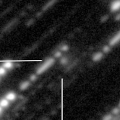
|
Now it is 16.0 mag (Mar. 17, ATLAS Chile). It brightens up to 16.5 mag from March to April. In the Southern Hemisphere, it stays observable in excellent condition. In the Northern Hemisphere, it will be getting higher gradually after this.
Date(TT) R.A. (2000) Decl. Delta r Elong. m1 Best Time(A, h)
Mar. 25 11 51.25 -48 25.9 0.915 1.753 132 16.7 23:41 ( 0, 77)
Apr. 1 11 57.54 -44 21.0 0.886 1.765 138 16.7 23:20 ( 0, 81)
|
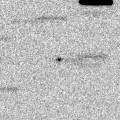
|
Now it is 16.6 mag (Mar. 5, ATLAS South Africa). It will be fading after this, and it will be fainter than 18 mag in early May. It locates somewhat low in the Southern Hemisphere.
Date(TT) R.A. (2000) Decl. Delta r Elong. m1 Best Time(A, h)
Mar. 25 13 35.24 30 14.0 0.453 1.386 142 16.7 1:28 (180, 25)
Apr. 1 13 32.02 29 4.4 0.486 1.423 144 16.9 0:58 (180, 26)
|
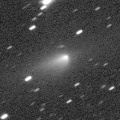
|
It brightened up to 12.7 mag in last year (Feb. 27, 2022, Jose Guilherme de S. Aguiar). Now it is fading. It has already faded down to 17.1 mag (Mar. 17, J.-C. Merlin). In the Southern Hemisphere, it stays observable until summer when it becomes fainter than 18 mag. It locates low in the Northern Hemisphere.
Date(TT) R.A. (2000) Decl. Delta r Elong. m1 Best Time(A, h)
Mar. 25 19 29.25 -25 7.5 2.866 2.757 73 16.8 4:42 (265, 54)
Apr. 1 19 37.53 -24 58.1 2.799 2.781 78 16.8 4:48 (260, 59)
|
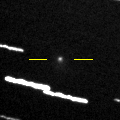
|
Now it is 15.8 mag (Mar. 19, Toshihiko Ikemura, Hirohisa Sato). It will be fading after this, and it will be fainter than 18 mag in early May. It is observable in excellent condition in the Northern Hemisphere. It locates low in the Southern Hemisphere.
Date(TT) R.A. (2000) Decl. Delta r Elong. m1 Best Time(A, h)
Mar. 25 7 25.23 45 46.4 1.360 1.837 101 16.8 19:29 (178, 10)
Apr. 1 7 18.17 39 10.6 1.467 1.842 94 17.0 19:19 (172, 16)
|
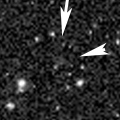
|
Now it is 16.8 mag (Mar. 19, ATLAS South Africa). Very far object. It stays 16-17 mag for a long time from 2021 to 2026. In the Southern Hemisphere, it stays observable in good condition for a long time. In the Northern Hemisphere, it is not observable at all.
Date(TT) R.A. (2000) Decl. Delta r Elong. m1 Best Time(A, h)
Mar. 25 4 56.39 -71 16.8 10.423 10.390 85 16.8 19:29 ( 18, 48)
Apr. 1 4 55.73 -70 39.0 10.412 10.385 85 16.8 19:19 ( 20, 47)
|

|
It has not been observed yet in this apparition. In the last apparition, it had faded before the perihelion passage. If it becomes as bright as its last apparition, it will brighten up to 17 mag. It stays observable in good condition for a long time.
Date(TT) R.A. (2000) Decl. Delta r Elong. m1 Best Time(A, h)
Mar. 25 14 14.64 3 57.6 1.884 2.788 149 17.0 2:08 (180, 51)
Apr. 1 14 12.39 4 44.6 1.836 2.774 155 17.0 1:38 (180, 50)
|
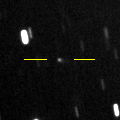
|
Now it is 17.5 mag (Mar. 12, ATLAS-HKO, Haleakala). In the Northern Hemisphere, it stays observable at 17 mag in good condition from spring to summer. In the Southern Hemisphere, it locates extremely low only in summer.
Date(TT) R.A. (2000) Decl. Delta r Elong. m1 Best Time(A, h)
Mar. 25 13 14.82 52 52.2 2.516 3.184 124 17.0 1:08 (180, 2)
Apr. 1 13 12.43 54 9.4 2.521 3.156 121 17.0 0:38 (180, 1)
|
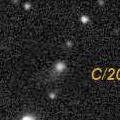
|
Now it is 16.7 mag (Mar. 18, ATLAS Chile). It stays 17 mag and observable in good condition until summer.
Date(TT) R.A. (2000) Decl. Delta r Elong. m1 Best Time(A, h)
Mar. 25 13 3.62 10 46.3 7.982 8.938 162 17.0 0:57 (180, 44)
Apr. 1 12 59.00 11 20.5 7.982 8.945 163 17.0 0:25 (180, 44)
|
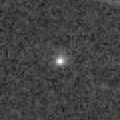
|
It was observed at 17 mag in 2022 autumn. It is observable at 17 mag also in 2023 spring.
Date(TT) R.A. (2000) Decl. Delta r Elong. m1 Best Time(A, h)
Mar. 25 20 22.78 4 27.8 2.099 1.779 57 17.1 4:42 (243, 26)
Apr. 1 20 14.88 6 26.1 1.979 1.815 65 17.1 4:48 (233, 32)
|
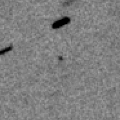
|
Now it is 16.8 mag (Mar. 19, Toshihiko Ikemura, Hirohisa Sato). It stays observable at 17 mag from spring to early summer. It locates low in the Southern Hemisphere.
Date(TT) R.A. (2000) Decl. Delta r Elong. m1 Best Time(A, h)
Mar. 25 9 8.98 37 54.6 1.927 2.597 121 17.2 20:59 (180, 17)
Apr. 1 9 9.87 37 25.6 1.986 2.585 116 17.2 20:33 (180, 18)
|
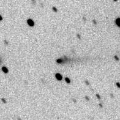
|
Now it is 16.8 mag (Mar. 2, ATLAS Chile). It will be fading and getting lower gradually after this. It will be unobservable in April in the Northern Hemisphere, or in May in the Southern Hemisphere.
Date(TT) R.A. (2000) Decl. Delta r Elong. m1 Best Time(A, h)
Mar. 25 4 37.51 4 39.4 3.851 3.561 65 17.2 19:29 (124, 32)
Apr. 1 4 44.60 5 12.2 3.943 3.569 61 17.3 19:19 (122, 30)
|
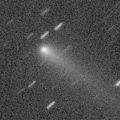
|
It brightened up to 14.1 mag in autumn (Nov. 14, Thomas Lehmann). Now it is fading. It has already faded down to 17.5 mag (Mar. 8, D. Buczynski). In the Northern Hemisphere, it stays observable in excellent condition for a while. In the Southern Hemisphere, it is not observable after this.
Date(TT) R.A. (2000) Decl. Delta r Elong. m1 Best Time(A, h)
Mar. 25 3 52.46 36 9.3 3.064 2.727 61 17.3 19:29 (138, 2)
Apr. 1 4 5.85 36 43.3 3.163 2.755 57 17.4 19:19 (138, 1)
|
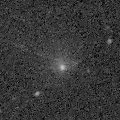
|
Now it is 17.1 mag (Mar. 13, ATLAS Chile). Very large comet. It is expected to brighten up to 14 mag in 2031. In the Southern Hemisphere, it stays observable in good condition for a long time. In the Northern Hemisphere, it is not observable until 2030.
Date(TT) R.A. (2000) Decl. Delta r Elong. m1 Best Time(A, h)
Mar. 25 2 39.49 -57 44.6 18.234 17.851 65 17.3 19:29 ( 40, 37)
Apr. 1 2 42.07 -57 34.8 18.199 17.826 66 17.3 19:19 ( 40, 35)
|
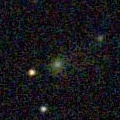
|
It brightened rapidly. Now it is 16.9 mag (Mar. 14, Purple Mountain Observatory, XuYi Station). It will be fading after this. It will be fainter than 18 mag in April.
Date(TT) R.A. (2000) Decl. Delta r Elong. m1 Best Time(A, h)
Mar. 25 9 52.76 22 5.5 1.291 2.141 138 17.4 21:43 (180, 33)
Apr. 1 9 54.09 21 50.3 1.372 2.170 131 17.6 21:17 (180, 33)
|

|
It brightened very rapidly up to 15.5 mag from last autumn to last winter (Nov. 2, 2021, Toshihiko Ikemura, Hirohisa Sato). Now it is fading slowly. It has already faded down to 16.8 mag (Mar. 19, Toshihiko Ikemura, Hirohisa Sato).
Date(TT) R.A. (2000) Decl. Delta r Elong. m1 Best Time(A, h)
Mar. 25 6 17.34 11 11.3 4.607 4.723 90 17.4 19:29 (154, 40)
Apr. 1 6 20.65 11 22.1 4.733 4.745 84 17.4 19:19 (150, 38)
|
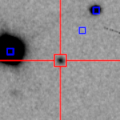
|
It will approach to Sun down to 0.4 a.u. in late September in 2024, and it is expected to brighten up to 0 mag. Now it is 17.3 mag (Mar. 18, Toshihiko Ikemura, Hirohisa Sato). It stays observable in good condition for a while. At the high light, in the Northern Hemisphere, it will be observable in good condition after the perihelion passage. In the Southern Hemisphere, it will be observable in the low sky before and after the perihelion passage.
Date(TT) R.A. (2000) Decl. Delta r Elong. m1 Best Time(A, h)
Mar. 25 15 14.05 0 7.7 6.305 7.045 134 17.5 3:07 (180, 55)
Apr. 1 15 10.68 0 31.6 6.169 6.982 141 17.4 2:36 (180, 55)
|
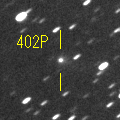
|
It brightened up to 15.3 mag in last winter (Jan. 12, 2022, H. Nohara). Now it is fading. It has already faded down to 17.2 mag (Mar. 15, ATLAS-HKO, Haleakala). It will be observable at 17 mag in good condition in next winter. It locates low in the Southern Hemisphere.
Date(TT) R.A. (2000) Decl. Delta r Elong. m1 Best Time(A, h)
Mar. 25 9 53.17 31 3.0 3.962 4.703 133 17.4 21:43 (180, 24)
Apr. 1 9 51.55 31 14.4 4.058 4.722 126 17.5 21:14 (180, 24)
|
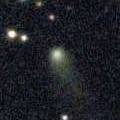
|
Now it is 17.3 mag (Mar. 10, Catalina Sky Survey). Fading slowly. In the Southern Hemisphere, it is not observable after this.
Date(TT) R.A. (2000) Decl. Delta r Elong. m1 Best Time(A, h)
Mar. 25 18 44.56 53 2.9 6.303 6.281 84 17.5 4:42 (197, -1)
Apr. 1 18 48.03 54 19.8 6.319 6.315 85 17.5 4:48 (192, -1)
|

|
Now it is 17.4 mag (Mar. 12, ATLAS-HKO, Haleakala). Fading slowly. In the Northern Hemisphere, it stays observable in good condition for a long time. In the Southern Hemisphere, it is not observable after this.
Date(TT) R.A. (2000) Decl. Delta r Elong. m1 Best Time(A, h)
Mar. 25 18 33.07 72 57.3 9.807 9.808 87 17.5 4:42 (188,-19)
Apr. 1 18 31.51 73 55.9 9.836 9.825 86 17.5 4:48 (185,-20)
|
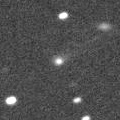
|
It brightened up to 15.9 mag in 2022 spring (May 5, Toshiyuki Takahashi). Now it is 17.4 mag (Mar. 18, J.-C. Merlin). In 2023, it is observable at 17.5 mag in spring.
Date(TT) R.A. (2000) Decl. Delta r Elong. m1 Best Time(A, h)
Mar. 25 16 31.40 -24 23.8 4.393 4.881 113 17.7 4:24 (180, 79)
Apr. 1 16 31.53 -24 30.5 4.302 4.888 120 17.7 3:57 (180, 80)
|
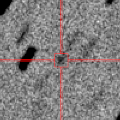
|
Now it is 17.9 mag (Mar. 21, John Maikner). It will be getting higher gradually, but it will be fading after this.
Date(TT) R.A. (2000) Decl. Delta r Elong. m1 Best Time(A, h)
Mar. 25 20 55.98 -3 16.0 2.433 1.943 49 17.8 4:42 (256, 25)
Apr. 1 21 8.09 -0 55.7 2.414 1.981 53 17.9 4:48 (250, 28)
|
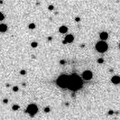
|
Now it is 18.4 mag (Mar. 18, ATLAS-HKO, Haleakala). It will be fading after this, and it will be fainter than 18 mag in April. It locates somewhat low in the Southern Hemisphere.
Date(TT) R.A. (2000) Decl. Delta r Elong. m1 Best Time(A, h)
Mar. 25 6 0.81 25 35.2 3.886 3.951 86 17.8 19:29 (156, 25)
Apr. 1 6 5.74 25 30.7 3.993 3.955 80 17.9 19:19 (153, 24)
|
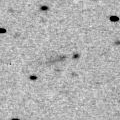
|
Now it is 18.2 mag (Feb. 27, Ken-ichi Kadota). It stays observable at 18 mag in good condition from January to March. It looks elongated.
Date(TT) R.A. (2000) Decl. Delta r Elong. m1 Best Time(A, h)
Mar. 25 10 7.89 16 9.6 3.332 4.182 144 17.8 21:58 (180, 39)
Apr. 1 10 6.22 16 20.5 3.394 4.180 136 17.9 21:28 (180, 39)
|
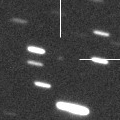
|
Now it is 18 mag (Feb. 11, Giuseppe Pappa). It stays 17.5 mag until spring. It is observable in good condition in the Northern Hemisphere. It is not observable in the Southern Hemisphere.
Date(TT) R.A. (2000) Decl. Delta r Elong. m1 Best Time(A, h)
Mar. 25 5 9.89 69 15.7 3.088 3.127 82 17.9 19:29 (167,-18)
Apr. 1 5 32.46 66 57.5 3.153 3.131 79 18.0 19:19 (166,-15)
|
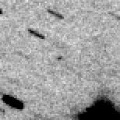
|
Now it is 17.8 mag (Feb. 27, H. Nohara). It returns for the first time in 70 years. It will brighten up to 4.5 mag in 2024 spring. In the Northern Hemisphere, it stays observable in good condition until 2024 spring while the comet will be brightening gradually. In the Southern Hemisphere, it is observable only in 2023 spring in the extremely low sky before the perihelion passage.
Date(TT) R.A. (2000) Decl. Delta r Elong. m1 Best Time(A, h)
Mar. 25 19 27.12 34 12.9 5.199 5.018 74 18.0 4:42 (212, 12)
Apr. 1 19 30.24 35 35.8 5.079 4.954 77 17.9 4:48 (206, 13)
|
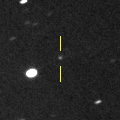
|
Now it is 17.9 mag (Mar. 10, A. Diepvens). It will brighten up to 15 mag from 2024 to 2025. In 2023, it is observable at 18 mag in spring.
Date(TT) R.A. (2000) Decl. Delta r Elong. m1 Best Time(A, h)
Mar. 25 9 30.08 26 22.4 3.606 4.333 131 17.9 21:20 (180, 29)
Apr. 1 9 27.94 26 17.6 3.675 4.321 124 17.9 20:50 (180, 29)
|
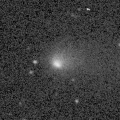
|
It brightened up to 14.6 mag in autumn (Oct. 19, Toshihiko Ikemura, Hirohisa Sato). Now it is fading. It has already faded down to 17.6 mag (Feb. 16, Toshihiko Ikemura, Hirohisa Sato). It will be fainter than 18 mag in spring.
Date(TT) R.A. (2000) Decl. Delta r Elong. m1 Best Time(A, h)
Mar. 25 3 47.21 14 45.9 2.853 2.411 54 17.9 19:29 (122, 16)
Apr. 1 4 0.06 15 33.3 2.943 2.435 50 18.1 19:19 (122, 15)
|

|
It will brighten up to 16.5 mag in summer. It stays observable in good condition for a long time.
Date(TT) R.A. (2000) Decl. Delta r Elong. m1 Best Time(A, h)
Mar. 25 21 27.04 -12 4.1 3.724 3.079 43 18.0 4:42 (268, 24)
Apr. 1 21 36.95 -11 33.1 3.651 3.073 48 17.9 4:48 (264, 28)
|
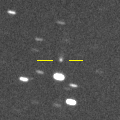
|
It was predicted to brighten up to 16 mag in 2023. But actually, it is very faint as 18.6 mag (Mar. 2, Taras Prystavski). In the Southern Hemisphere, it stays observable in good condition for a long time. In the Northern Hemisphere, it will never be observable again.
Date(TT) R.A. (2000) Decl. Delta r Elong. m1 Best Time(A, h)
Mar. 25 19 21.11 -74 38.5 3.162 3.266 87 18.0 4:42 (346, 46)
Apr. 1 19 44.70 -74 60.0 3.121 3.275 89 18.0 4:48 (347, 47)
|
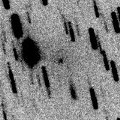
|
Tiny comet, but it approached to Sun down to 0.8 a.u. in January, and it will approach to Earth down to 0.6 a.u. in March. It was expected to brighten up to 14 mag from January to March. But actually, it became disintegrated before the perihelion passage. Now it is extremely faint as 18.2 mag (Feb. 20, Thomas Lehmann). In the Southern Hemisphere, it stays observable in good condition for a long time. It becomes observable in good condition after this also in the Northern Hemisphere.
Date(TT) R.A. (2000) Decl. Delta r Elong. m1 Best Time(A, h)
Mar. 25 7 8.40 -3 23.4 0.759 1.389 103 19.8 19:29 (167, 57)
Apr. 1 7 31.03 5 54.1 0.899 1.480 102 20.3 19:19 (171, 48)
|
|
![]()
 C/2021 S3 ( PanSTARRS )
C/2021 S3 ( PanSTARRS ) C/2022 U2 ( ATLAS )
C/2022 U2 ( ATLAS ) C/2022 P1 ( NEOWISE )
C/2022 P1 ( NEOWISE ) 118P/Shoemaker-Levy 4
118P/Shoemaker-Levy 4 C/2020 S4 ( PanSTARRS )
C/2020 S4 ( PanSTARRS ) C/2021 X1 ( Maury-Attard )
C/2021 X1 ( Maury-Attard ) C/2021 G2 ( ATLAS )
C/2021 G2 ( ATLAS ) 300P/Catalina
300P/Catalina 96P/Machholz 1
96P/Machholz 1 C/2022 E2 ( ATLAS )
C/2022 E2 ( ATLAS ) C/2020 R7 ( ATLAS )
C/2020 R7 ( ATLAS ) 117P/Helin-Roman-Alu 1
117P/Helin-Roman-Alu 1 C/2022 L2 ( ATLAS )
C/2022 L2 ( ATLAS ) 119P/Parker-Hartley
119P/Parker-Hartley 126P/IRAS
126P/IRAS 199P/Shoemaker 4
199P/Shoemaker 4 C/2021 E3 ( ZTF )
C/2021 E3 ( ZTF ) C/2022 W3 ( Leonard )
C/2022 W3 ( Leonard ) C/2022 A3 ( Lemmon-ATLAS )
C/2022 A3 ( Lemmon-ATLAS ) C/2018 U1 ( Lemmon )
C/2018 U1 ( Lemmon ) 94P/Russell 4
94P/Russell 4 P/2023 B1 ( PanSTARRS )
P/2023 B1 ( PanSTARRS ) C/2023 E1 ( ATLAS )
C/2023 E1 ( ATLAS ) C/2023 B2 ( ATLAS )
C/2023 B2 ( ATLAS ) 263P/Gibbs
263P/Gibbs 116P/Wild 4
116P/Wild 4 C/2023 A1 ( Leonard )
C/2023 A1 ( Leonard ) C/2019 E3 ( ATLAS )
C/2019 E3 ( ATLAS ) 280P/Larsen
280P/Larsen C/2022 U4 ( Bok )
C/2022 U4 ( Bok ) C/2020 F2 ( ATLAS )
C/2020 F2 ( ATLAS ) C/2022 Q2 ( ATLAS )
C/2022 Q2 ( ATLAS ) 180P/NEAT
180P/NEAT 408P/2020 M7 ( Novichonok-Gerke )
408P/2020 M7 ( Novichonok-Gerke ) P/2022 L3 ( ATLAS )
P/2022 L3 ( ATLAS ) C/2014 UN271 ( Bernardinelli-Bernstein )
C/2014 UN271 ( Bernardinelli-Bernstein ) 204P/LINEAR-NEAT
204P/LINEAR-NEAT P/2021 N2 ( Fuls )
P/2021 N2 ( Fuls ) C/2023 A3 ( Tsuchinshan-ATLAS )
C/2023 A3 ( Tsuchinshan-ATLAS ) 402P/2020 Q3 ( LINEAR )
402P/2020 Q3 ( LINEAR ) C/2020 H6 ( ATLAS )
C/2020 H6 ( ATLAS ) C/2019 O3 ( Palomar )
C/2019 O3 ( Palomar ) 99P/Kowal 1
99P/Kowal 1 80P/Peters-Hartley
80P/Peters-Hartley 244P/Scotti
244P/Scotti 452P/2022 B5 ( Sheppard-Jewitt )
452P/2022 B5 ( Sheppard-Jewitt ) C/2022 W2 ( ATLAS )
C/2022 W2 ( ATLAS ) 12P/Pons-Brooks
12P/Pons-Brooks 65P/Gunn
65P/Gunn 61P/Shajn-Schaldach
61P/Shajn-Schaldach 287P/Christensen
287P/Christensen C/2021 C5 ( PanSTARRS )
C/2021 C5 ( PanSTARRS ) C/2022 S3 ( PanSTARRS )
C/2022 S3 ( PanSTARRS )![]()

































































